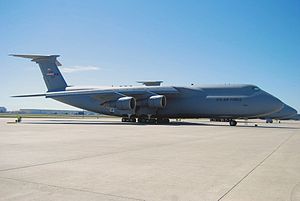|
356th Airlift Squadron
The 356th Airlift Squadron is a United States Air Force Reserve squadron, assigned to the 433d Operations Group Air Force Reserve Command, stationed at Kelly Field Annex, Joint Base San Antonio, Texas. The 356th is a C-5M Super Galaxy Formal Training Unit. The squadron was first activated in 1942 as the 356th Bombardment Squadron, and served as a training unit until the spring of 1944, when it was inactivated in a reorganization of training units by the Army Air Forces. It was activated again as a Boeing B-29 Superfortress unit. It deployed to the Pacific in the spring of 1945 and participated in the strategic bombing campaign against Japan, earning a Distinguished Unit Citation. After V-J Day, the squadron remained in the Pacific until 1946, when it was inactivated. The squadron was redesignated the 356th Troop Carrier Squadron and activated in the military reserve force in 1949, but was inactivated a few months later. When the reserves resumed flying operations after the Korean War, the squadron was activated again in 1952. It served continuously in the reserve until 2006, being mobilized during the Cuban Missile Crisis. It was activated in its current role in 2007. MissionThe squadron operates the Air Force Reserve's only Formal Training Unit providing initial and advanced C-5 flight qualification for Air Mobility Command, Air National Guard and Air Force Reserve Command aircrews.[3] HistoryWorld War IIBombardment training unitConstituted 356 Bombardment Squadron (Heavy) on 28 January 1942. Activated with B-24 bombers on 1 June 1942 at Geiger Field, WA. Moved to; Davis-Monthan Field, AZ, 23 Jun 1942 and trained aircrews for bombardment missions. Relocated to Wendover Field, UT, 30 Jul 1942; Pueblo AAB, CO, 30 Sep 1942; Davis-Monthan Field, AZ, 1 Dec 1942; Clovis, NM, 29 Jan 1943; Langley Field, VA, 17 Dec 1943 & Chatham AAFld, GA, 27 Jan-10 Apr 1944. Operating B-17, 1944; B-29, 1945-1946. Inactivated on 10 April 1944.[1] Combat in the PacificRedesignated as a Boeing B-29 Superfortress very heavy bombardment Squadron under Second Air Force on 7 April 1944 at Dalhart Army Air Field, Texas. Initially equipped with Boeing B-17 Flying Fortresses for training, due to shortage of B-29 Superfortresses. Moved to McCook Army Air Field, Nebraska, in August 1944 and equipped with B-29B limited production aircraft.[1] After completion of training deployed to Central Pacific Area, assigned to XXI Bomber Command, Northwest Field (Guam) for operational missions. B-29Bs were standard production aircraft stripped of most defensive guns to increase speed and bomb load, The tail gun was aimed and fired automatically by the new AN/APG-15B radar fire control system that detected the approaching enemy plane and made all the necessary calculations. Mission of the squadron was the strategic bombardment of the Japanese Home Islands. Entered combat on 16 June 1945 with a bombing raid against an airfield on Moen. Flew first mission against the Japanese home islands on 26 June 1945 and afterwards operated principally against the enemy's petroleum industry. Flew primarily low-level, fast attacks at night using a mixture of high-explosive and incendiary bombs to attack targets. Flew last combat mission on 15 August 1945, later flew in "Show of Force" mission on 2 September 1945 over Tokyo Bay during formal Japanese Surrender. Inactivated on Guam 15 April 1946, personnel returned to the United States and aircraft sent to storage in Southwest United States. Reserve operationsIt trained for Douglas C-54 Skymaster airlift operations from 1949–1950 and for troop carrier missions from 1952–1967. The squadron airlifted troops and their equipment during the Cuban Missile Crisis, October–November 1962. From 1970–1971 the squadron trained for special operations.[1] Between 1971 and 2006 it trained for and flew airlift missions, participating in exercises, supporting unit deployments, taking part in special assignment airlift missions, and rotating periodically to Panama. The 356th supported liberation of Kuwait in 1991. It converted from tactical to strategic aircraft and was renamed 356 Airlift Squadron in 1992. Operating C-141 Starlifters between 1992-2006 and provided strategic airlift until 30 June 2006 when the squadron was inactivated. Activated in the Reserve on 9 January 2007.[1] Since 2007 the 356th has conducted air crew training for the Lockheed C-5 Galaxy. The final C-5A Galaxy aircraft (tail number 70-0448) departed Kelly Field on September 28, 2016. The first of the eight Lockheed Martin C-5M Super Galaxy aircraft, arrived June 2016.[4] Operations and decorations
Lineage
Assignments
Bases stationed
Aircraft
ReferencesNotes
Bibliography
External links |
||||||||||||||||||||||||||||||||||||






